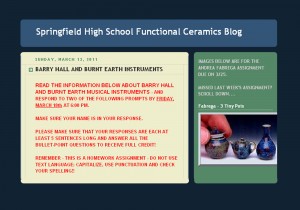 The number of blogs about ceramic musical instruments isn’t likely to make anyone’s Top 10 list of popularly read blogs on the internet, however, there are creative educators who are connecting the dots. One such blog involves Ms. B’s functional ceramics class at Springfield High School in Springfield, PA. I commend Ms. B. and her class for exploring the world of ceramic musical instruments and for using a blog to express ideas and responses to the online questions. I would guess that some of her students view the assignments as just one more thing they have to do, but what they may not realize is the value of writing, sharing, and community building that an online presence offers. Kudos to Ms. B and the several blogs she uses with her ceramics classes! Nicely done!!
The number of blogs about ceramic musical instruments isn’t likely to make anyone’s Top 10 list of popularly read blogs on the internet, however, there are creative educators who are connecting the dots. One such blog involves Ms. B’s functional ceramics class at Springfield High School in Springfield, PA. I commend Ms. B. and her class for exploring the world of ceramic musical instruments and for using a blog to express ideas and responses to the online questions. I would guess that some of her students view the assignments as just one more thing they have to do, but what they may not realize is the value of writing, sharing, and community building that an online presence offers. Kudos to Ms. B and the several blogs she uses with her ceramics classes! Nicely done!!
Whistling Vessel Video
03.21
I forgot to add a link to the Whistling Vessel Video that I loaded onto YouTube last week. There will be better videos but probably not better tunes coming from the vessels *grin*.
Here is the Windows Media Video file (.wmv) version, uploaded for WordPress:
Whistling Vessel Testing.
Experimentation continues on ceramic musical instruments. New pieces are expected out of the kiln next week (not much of a cliffhanger, right?).
Whistling Vessel Mystery
03.20
Novel writing hit a speed bump last year when I discovered that there were actual, historical artifacts that related to my protagonist’s quest to discover the source of mesoamerican, ceramic instrumental music. OK, so it wasn’t a speed bump, it was more like an aha-moment-stop-the-presses event that sent me into a frenzy of applied research and experimentation. Whistling vessels are a fascinating mystery. Whistling jars that involve the use of water are even more mysterious. The key word for the historical fiction writer exploring these artifacts is mystery.
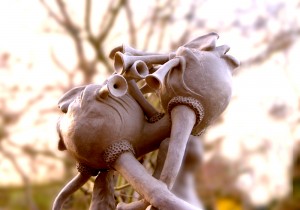 In contemporary circles there seem to be a couple of theories regarding the use of whistling vessel artifacts found primarily from present day Mexico to Peru. Donald Wright makes a solid case in Peruvian Whistling Vessels that their use involved making metaphysical or supernatural connections:
In contemporary circles there seem to be a couple of theories regarding the use of whistling vessel artifacts found primarily from present day Mexico to Peru. Donald Wright makes a solid case in Peruvian Whistling Vessels that their use involved making metaphysical or supernatural connections:
“…A discovery utilizing sound that could transport human beings into a new and unique realm of experience…possibly to other worlds of existence. This sound was not music, but instead a special toning of whistles which, when blown together with other such vessels, had the ability to induce what has been described as a trance state of a spiritual nature.”
Brian Ransom, (educator, clay artist, musician, and researcher) writes that water rather than human breath played a role in the function of whistling water jars. His extensive studies into the actual construction and artistic characteristic make a solid case that these instruments may have served a variety of functions but ultimately compound the mystery of their actual use:
“Music, ritual and contact with more-than-human realms via hallucinogenic substances as well as in everyday belief systems are prevalent among indigenous South Americans today. We can speculate that these mystical religious beliefs were also prevalent in ancient times. With these thoughts in mind, we can theorize that whistling jars were used as a means of spiritual contact.”
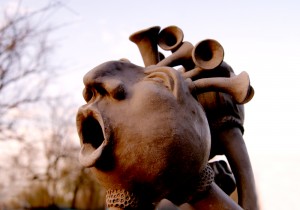 Toward the end of Don Wright’s article are suggestions that whistling vessels were very personal, evidenced by their presence in a number of Pre-Columbian burial sites. Equally intriguing is the concept that the mysteries of the spiritual qualities, construction, and inherent powers are passed along to select individuals from one generation to another. I count myself as a skeptic to the mysticism and powers of an inanimate object, even a whistling vessel. When demonstrated, however, the reactions by individuals who see and hear, first-hand a whistling vessel in use is often an other-wordly, “Wow”. Those reactions alone are sufficient for Dr. Ephriam Bowen to delve further into the mystery of ancient, ceramic musical instruments as well as the keepers of the skill to construct these enigmatic works of art. The time is approaching that my old friend Ephriam will pick up his pen and wrap up The MugPhlute Chronicles.
Toward the end of Don Wright’s article are suggestions that whistling vessels were very personal, evidenced by their presence in a number of Pre-Columbian burial sites. Equally intriguing is the concept that the mysteries of the spiritual qualities, construction, and inherent powers are passed along to select individuals from one generation to another. I count myself as a skeptic to the mysticism and powers of an inanimate object, even a whistling vessel. When demonstrated, however, the reactions by individuals who see and hear, first-hand a whistling vessel in use is often an other-wordly, “Wow”. Those reactions alone are sufficient for Dr. Ephriam Bowen to delve further into the mystery of ancient, ceramic musical instruments as well as the keepers of the skill to construct these enigmatic works of art. The time is approaching that my old friend Ephriam will pick up his pen and wrap up The MugPhlute Chronicles.
Pictured here is the work-in-progress whistling water vessel that will likely inspire Dr. Bowen’s fictional accounts.
Sculpture in Music?
02.28
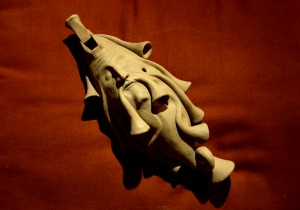 Deb and I have both laughed at the influence that “Davey Jones” from Pirates of the Caribbean: Dead Man’s Chest may have had on this particular piece. I had mentioned something about the remarkable make-up job and the animation of Davey’s tentacles while watching the movie just recently. I can accept that there may have been a seed planted, but I’d really like to think that this particular clay musical instrument, an ocarina, is an exploration of sculpture.
Deb and I have both laughed at the influence that “Davey Jones” from Pirates of the Caribbean: Dead Man’s Chest may have had on this particular piece. I had mentioned something about the remarkable make-up job and the animation of Davey’s tentacles while watching the movie just recently. I can accept that there may have been a seed planted, but I’d really like to think that this particular clay musical instrument, an ocarina, is an exploration of sculpture.
So many traditional brass instruments are remarkable works of functional, sculptural art and for the most part are admired only as a delivery system for music, and not as works of art that stand on their own merit. Flutes and tone sculptures from numerous ancient civilizations are highly decorated, well formed works of art that are celebrated in museums across the globe. Somewhere along the industrial revolution time line, we lost the celebration of the artist-craftsman-instrument-maker and the products of their hands. This Oca-regal is simply an effort to add attention to the sculptural qualities of a simple, ceramic flute. This is a variation on a theme from my previous projects, but I am thinking this direction may have some merit for instruments that are intentionally made to be displayed rather than locked up in an instrument case.
Ceramic Musical Instruments in First Art Exhibit
02.18
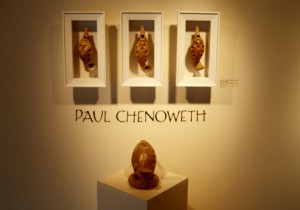 Belmont University’s Third Annual Alumni Art Exhibit includes several of my latest efforts at producing ceramic musical instruments. Two separate areas of the exhibit display Escape Series percussion instruments and ocarinas. Eight Belmont alumni are showing works that range from traditional oil paintings to a personally published/printed children’ s book to pen/ink graphic sketches. The show is located in Gallery 121 in Belmont University’s Leu Center for the Visual Arts and will run through March 3, 2011.
Belmont University’s Third Annual Alumni Art Exhibit includes several of my latest efforts at producing ceramic musical instruments. Two separate areas of the exhibit display Escape Series percussion instruments and ocarinas. Eight Belmont alumni are showing works that range from traditional oil paintings to a personally published/printed children’ s book to pen/ink graphic sketches. The show is located in Gallery 121 in Belmont University’s Leu Center for the Visual Arts and will run through March 3, 2011.
Thursday afternoon, I was invited to talk to students and visiting alumni about the instruments in a brief gallery talk. Many in the group seemed surprised that the ocarinas actually play full scales and other seemed fascinated by the goat skin drum heads. Although neither a drummer or a flautist, I was able to demonstrate the traditional Udu’s, the experimental Doumbeks, and several of the ocarinas. It may be time to expand my flute repertoire beyond a feeble version of This Old Man that I learned in a third grade song flute class.
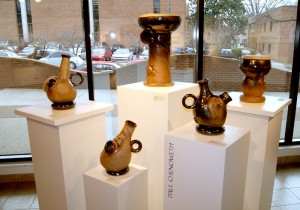 My general nervousness of showing ceramic work for the first time in an exhibit was erased early by compliments from other instructors. Belmont is such a supportive place for creative endeavors… I should have anticipated the encouraging words. Many thanks to Belmont’s Office of Alumni Relations for their faith in me for pulling together the alumni exhibit!
My general nervousness of showing ceramic work for the first time in an exhibit was erased early by compliments from other instructors. Belmont is such a supportive place for creative endeavors… I should have anticipated the encouraging words. Many thanks to Belmont’s Office of Alumni Relations for their faith in me for pulling together the alumni exhibit!
The body of work continues to grow. In the next two months, I anticipate production of a new series of instruments with a heavy historical context, elements of sculpture, more experimentation in functions, and perhaps a nod to the traditional face jugs of Appalachia.
Here are a few Flickr.com images from the exhibit.
Clay Ocarina – “Escape” Series
01.30
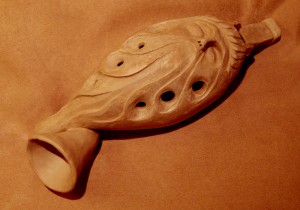 While I am patiently waiting for all of the new Udu’s to dry, I have ventured back to a familiar friend for a new series of ocarinas. Changes in the way that I construct and assemble the airway tubes made things much more predictable for extending the tonal range of these pinch pot construction ceramic musical instruments. New to this series is the addition of facial features embossed on the front surface of the ocarina. These gnome-like faces are figuratively escaping the bonds of the clay but do not reveal themselves in complete detail. They are a metaphor for the music that also escapes the hollow body of the instrument, reaching the human ear only when someone (musician) is there to force the music to leave.
While I am patiently waiting for all of the new Udu’s to dry, I have ventured back to a familiar friend for a new series of ocarinas. Changes in the way that I construct and assemble the airway tubes made things much more predictable for extending the tonal range of these pinch pot construction ceramic musical instruments. New to this series is the addition of facial features embossed on the front surface of the ocarina. These gnome-like faces are figuratively escaping the bonds of the clay but do not reveal themselves in complete detail. They are a metaphor for the music that also escapes the hollow body of the instrument, reaching the human ear only when someone (musician) is there to force the music to leave.
This limited series is hand built from a small batch of recycled stoneware that I have been hoarding for over a year. During that period, the aging process produced a very plastic and workable clay perfect for pinch pot construction. So far, there are 5 of these ocarinas completed and ready for firing. 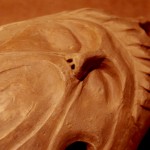 Each has been designed for display as a wall-hung sculpture and each one is a fully functional single octave+ flute that employs typical penny whistle or song flute fingering. Construction generally takes about 3-4 hours for each, excluding time needed between construction and carving phases to allow the clay partial drying.
Each has been designed for display as a wall-hung sculpture and each one is a fully functional single octave+ flute that employs typical penny whistle or song flute fingering. Construction generally takes about 3-4 hours for each, excluding time needed between construction and carving phases to allow the clay partial drying.
With a little luck and a happy reduction firing schedule, the Escape Series will make it into the gallery in about three weeks.
Experimental Ceramic Drums
01.13
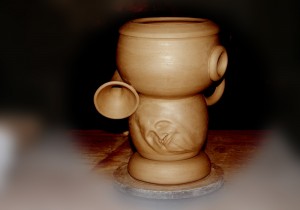 I would love to give someone else credit for the inspiration of this piece. I looked at so many images of Udus, Doumbeks, and Directional Conga drums. Somehow, this assembled mixture of parts is the result of numerous sketches and several great ideas from other artists.
I would love to give someone else credit for the inspiration of this piece. I looked at so many images of Udus, Doumbeks, and Directional Conga drums. Somehow, this assembled mixture of parts is the result of numerous sketches and several great ideas from other artists.
First of all, the stoneware drum is assembled from 6 wheel-thrown parts. The upper-most portion is designed to accept a stretched, goat skin head that will be secured just below the lower lip of the top opening. A ring-hole that references the side hole of traditional Udu drums is one of two outlet holes that come into play when the drum head is played…it could also be played, using this hole, like a Udu.
The lower portion of the drum is a closed bowl resting on a permanent ring stand. This is probably a no-no for the percussion community, but this piece is intended more for display than actual use and I wanted the vertical display to be the only option.
The bell-shaped piece connects to the upper drum-bowl and is a funcional outlet for sound, much like a directional Conga. The sculpted face has been pushed/altered from the wheel thrown piece to imply a human element attempting to escape the bonds of the ceramic musical instrument. That aspect may be emphasized at the glazing/staining stage to relate the bell-horn shape with the trapped face.
To provide interest on what might be a plain back to this instrument, two wheel-thrown rings are attached that might function as strap connectors… I am a bit shaky on that thought at the moment but will wait to get a feel of the overall weight and strength of the piece before determining if these rings will provide a function other than decoration.
Four other experimental clay drums are currently drying in hopes that some of these will be ready in time to be featured in the upcoming Alumni Art Exhibit at Belmont University’s Homecoming next month.
